Tag Archive: alignment
July 10, 2014
“In spite of current ads and slogans, the world doesn’t change one person at a time. It changes as networks of relationships form among people who discover they share a common cause and vision of what’s possible.”
-Margaret Wheatley and Deborah Frieze (2006)

For the past two years, I’ve had the fortune of partnering with Carole Martin to create and deliver a network leadership development program for regional and economic development in “the north country” (northern NH, southern Quebec, eastern VT). This opportunity was made possible by funding from the Neil and Louise Tillotson Foundation and took the form of something we called the Community Practitioners Network (CPN). Subsequently, some of the members of the first cohort have taken to calling it the “Community Placemakers Network” (more on that another time).
One of the first steps Carole and I took in creating the program was to begin with a set of principles, which, in good network fashion, evolved over time. These principles guided our design and facilitation of the program as it emerged, and we offered them to and co-evolved them with the cohort as they considered how to bring them to their own leadership in their organizations, communities, and beyond. Here is a condensed version of the lastest iteration of the principles:
- Look for what is beyond the immediate sight lines and intersections – Part of the power of networks is emergence; expect and delight in the unexpected that comes from the meeting of different minds and perspectives.
- Design for serendipity – Don’t try to control and account for all outcomes. First of all, it’s impossible. Secondly, as Andrew Goldsworthy once said, “Too much control can kill a work.”
- Periphery, not (just) center – Network action is not simply about what is happening “in the room” but what transpires “after the meeting,” not what goes on at a “steering group” level, but what happens in two-sies and three-sies that form/partner/innovate “out there.”
- Process sometimes counts as action – Creating stronger connections and building alignment among network members/participants can be significant progress.
- We move at the speed of trust – Make time and space for trust to be built.
- Contribution before credential – Contributions are what count, and can come from anyone.
- Feed the network through questions so that it has a life of its own – Using inquiry can help to unlock network potential in the pursuit of unique and context-specific answers.
Always eager to hear others and how you have put them to use . . .
June 26, 2014
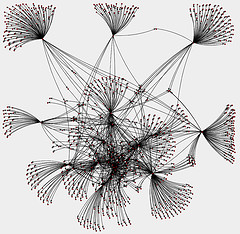
Picking up on the spirit of yesterday’s post about asking “beautiful questions” and inspired by a staff challenge to articulate lines of inquiry stemming from IISC’s core lenses, I offer this post. It distills some of the underlying questions that adopting a “network lens” inspires for social change work. Please add, adjust, edit, and rift!
- How does your organization/network/change initiative strive to add value to (rather than duplicate) existing efforts? What do you do best, and how might you then connect to the rest?
- What are you doing to support and strengthen connections and alignment within and beyond your organization/network/change initiative?
Read More
June 18, 2014
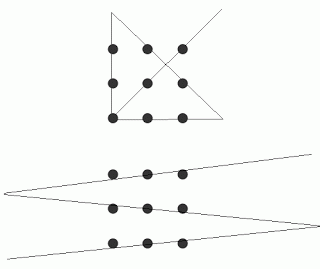
You probably know this challenge. Start with 3 rows of 3 dots in the form of a square. Now using only three or four straight lines, connect all of the dots without lifting your pen or pencil from the paper (see answers above). I was reminded of this exercise by some of the participants in the Tillotson Fund Community Practitioners Network (CPN). They used it as a metaphor during a presentation about a multi-functional collaborative platform they are proposing to connect a rather vast and disparate region of New Hampshire’s northern most county, including parts of western Vermont, southern Quebec, and eastern Maine. The vision for the platform is that it would help to build connectivity and alignment around a core set of regional values that would also inspire action for community and economic development. Read More
April 16, 2014

Photo by Kevin Doyle. Some rights reserved.
Conferences and other large in-person convenings provide a great opportunity to launch and further develop networks for social change. As has been mentioned previously on this blog, and borrowing from the work of Plastrik and Taylor, at IISC we see networks for change as developing in various inter-related “modes,” including connectivity, alignment, and action. Paying attention to multiple dimensions of success can inform a variety of approaches to support a more robust, trust-bound, commonly-oriented, self-organizing and (as needed) formally coordinated collective.
Here are some methods to consider for convenings to help feed and grow networks for social change: Read More
March 26, 2014

Over the last few weeks I have fielded a number of calls from people who are interested in figuring out how to develop different kinds of networks. I’m always eager to have these conversations, precisely because there is no single right answer, and it really comes down to a process of discovery and experimentation based on the unique nature of the network and system in question. That said, I do like to ask people the question, “What are you doing to feed your network?” Read More
March 5, 2014

I just finished reading Mila Baker’s Peer-to-Peer Leadership: Why the Network is the Leader, which adds to the growing case for more widespread network thinking, foregrounding of human relationships, and shifting traditional conceptions (and myths) of leadership in business and beyond. Much of what Baker writes about has been expressed in the writings of others, including Clay Shirky, Carol Sanford, Nilofer Merchant, Kevin Kelly, and Harold Jarche, and I appreciate how she couches much of her writing in the evolving leadership and organizational development literature and thinking. Read More
December 11, 2013
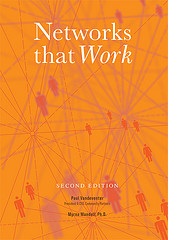
I’ve spent time the past week reading through Networks that Work, a handy and concise resource for developing organizational networks, written by Paul Vandeventer, President and CEO of Community Partners, and Myrna Mandell, Ph.D. The book lays out some very helpful pointers for more formally constructed networks. I have highlighted 10 points below that resonate with our experiences at IISC around supporting organizational networks for social change. My comments and extensions are in italics: Read More
November 6, 2013
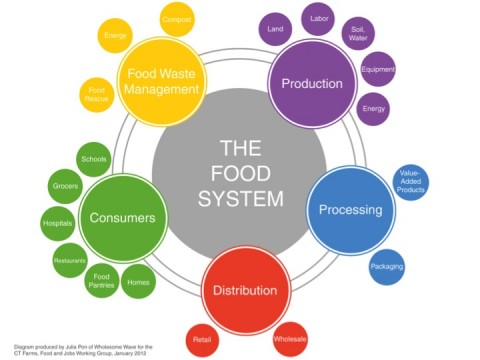
Last Friday, I worked with the Network Support Team (NST) of the Connecticut Food System Alliance (CFSA) to facilitate a gathering of over 100 food system and food security activists. This was the fourth convening in the past year and a half, and featured what have become typical elements of fostering connectivity between people (welcoming and introducing ourselves to new people, learning together, making offers and requests) and alignment around the CFSA vision. And to honor what has been growing in the network as both a call for and a question about the possibility of collective action, NST members Melissa Spear, Marilyn Moore, and Jiff Martin created the following exercise to stimulate people’s thinking about how the network could “change the game” in Connecticut and boldly advance the state towards a reality where “everyone has access to safe, nutritious, culturally appropriate, and affordable food.” Read More
October 31, 2013

As I mentioned in yesterday’s post, this week the Vermont Farm to Plate (F2P) Network held its third annual convening. This marked the move to the third year of the F2P Network’s existence, and another significant milestone.
At the first convening in 2011, there was a mix of enthusiasm, optimism, curiosity, impatience, and some reticence. Many were intrigued by the notion of this new form of multi-organizational collaboration seeking to double local food production in 10 years time, boost the state economy, and address issues of food access and security. Read More
October 17, 2013
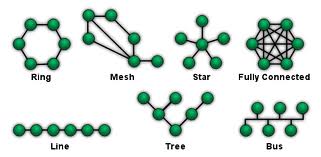
I had a virtual exchange the other day with Jane Wei-Skillern of Stanford University, as we discussed different ideas for going beyond case studies to help engage people in thinking in networked ways. This is what came to mind at the time, and I am eager to hear from others what you have done:
- In the past I have asked people to think about network forms or topologies (hub and spoke, mesh, distributed); assign different forms to pairs/trios and have them think about what examples of that form exist in their lives. What are the strengths of that form? What are its limitations? How might they shift it to be more “effective” in terms of desired impact?
Read More
September 25, 2013

Our friend Jane Wei-Skillern recently co-wrote (along with Nora Silver and Eric Heitz) another valuable contribution to the growing “network building” body of literature, entitled “Cracking the Network Code: Four Principles for Grantmakers.” This piece is part of Grantmakers for Effective Organizations’ learning initiative, Scaling What Works. While the guide mainly addresses funders, it also has something for those outside of the philanthropic world. Its core offering is a set of principles to guide what the authors call “the network mindset”: Read More
July 31, 2013
“Thinking in terms of networks can enable us see with new eyes.”
– Harold Jarche

Photo by David Shankbone
The biological sciences have revealed that all living things in an ecosystem are interconnected through networks of relationship; that is, they literally depend upon a web of life to survive and to thrive. On the social science front, we are also beginning to appreciate that groups, organizations, and communities depend upon and function in distributed networks of relationship that go beyond contrived boundaries, formal roles, communications, or decision-making protocols. After all, we are a part of life! Read More












